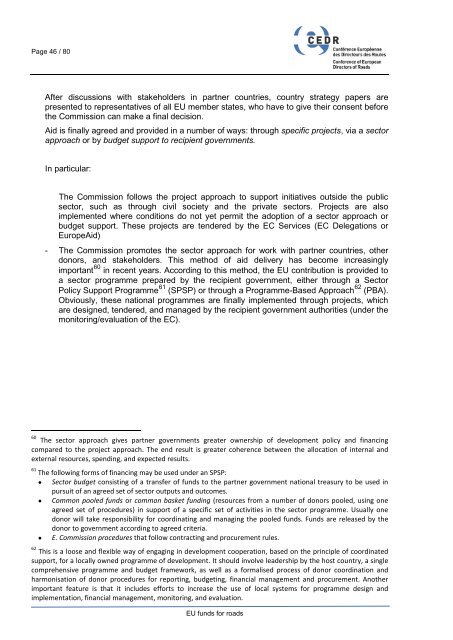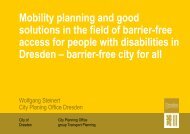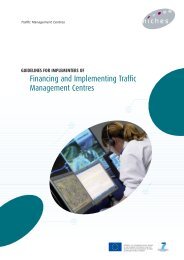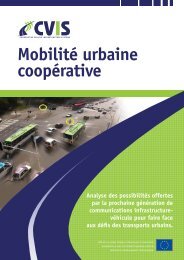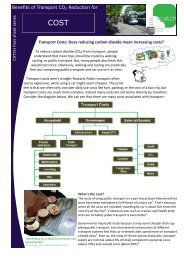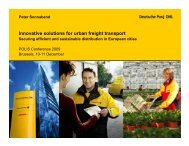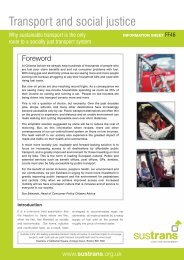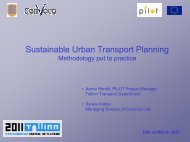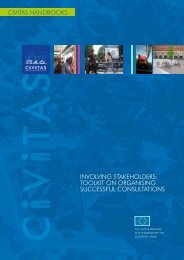EU funds for roads - CEDR
EU funds for roads - CEDR
EU funds for roads - CEDR
You also want an ePaper? Increase the reach of your titles
YUMPU automatically turns print PDFs into web optimized ePapers that Google loves.
- The<br />
Page 46 / 80<br />
After discussions with stakeholders in partner countries, country strategy papers are<br />
presented to representatives of all <strong>EU</strong> member states, who have to give their consent be<strong>for</strong>e<br />
the Commission can make a final decision.<br />
Aid is finally agreed and provided in a number of ways: through specific projects, via a sector<br />
approach or by budget support to recipient governments.<br />
In particular:<br />
Commission follows the project approach to support initiatives outside the public<br />
sector, such as through civil society and the private sectors. Projects are also<br />
implemented where conditions do not yet permit the adoption of a sector approach or<br />
budget support. These projects are tendered by the EC Services (EC Delegations or<br />
EuropeAid)<br />
- The Commission promotes the sector approach <strong>for</strong> work with partner countries, other<br />
donors, and stakeholders. This method of aid delivery has become increasingly<br />
important 60 in recent years. According to this method, the <strong>EU</strong> contribution is provided to<br />
a sector programme prepared by the recipient government, either through a Sector<br />
Policy Support Programme 61 (SPSP) or through a Programme-Based Approach 62 (PBA).<br />
Obviously, these national programmes are finally implemented through projects, which<br />
are designed, tendered, and managed by the recipient government authorities (under the<br />
monitoring/evaluation of the EC).<br />
60 The sector approach gives partner governments greater ownership of development policy and financing<br />
compared to the project approach. The end result is greater coherence between the allocation of internal and<br />
external resources, spending, and expected results.<br />
61 The following <strong>for</strong>ms of financing may be used under an SPSP:<br />
• Sector budget consisting of a transfer of <strong>funds</strong> to the partner government national treasury to be used in<br />
pursuit of an agreed set of sector outputs and outcomes.<br />
• Common pooled <strong>funds</strong> or common basket funding (resources from a number of donors pooled, using one<br />
agreed set of procedures) in support of a specific set of activities in the sector programme. Usually one<br />
donor will take responsibility <strong>for</strong> coordinating and managing the pooled <strong>funds</strong>. Funds are released by the<br />
donor to government according to agreed criteria.<br />
• E. Commission procedures that follow contracting and procurement rules.<br />
62 This is a loose and flexible way of engaging in development cooperation, based on the principle of coordinated<br />
support, <strong>for</strong> a locally owned programme of development. It should involve leadership by the host country, a single<br />
comprehensive programme and budget framework, as well as a <strong>for</strong>malised process of donor coordination and<br />
harmonisation of donor procedures <strong>for</strong> reporting, budgeting, financial management and procurement. Another<br />
important feature is that it includes ef<strong>for</strong>ts to increase the use of local systems <strong>for</strong> programme design and<br />
implementation, financial management, monitoring, and evaluation.<br />
<strong>EU</strong> <strong>funds</strong> <strong>for</strong> <strong>roads</strong>


